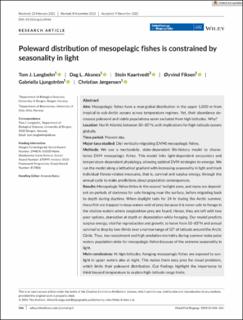| dc.contributor.author | Langbehn, Tom | |
| dc.contributor.author | Aksnes, Dag Lorents | |
| dc.contributor.author | Kaartvedt, Stein | |
| dc.contributor.author | Fiksen, Øyvind | |
| dc.contributor.author | Ljungström, Anna Jeja Gabriella | |
| dc.contributor.author | Jørgensen, Christian | |
| dc.date.accessioned | 2022-02-02T12:51:01Z | |
| dc.date.available | 2022-02-02T12:51:01Z | |
| dc.date.created | 2022-01-08T12:01:59Z | |
| dc.date.issued | 2022 | |
| dc.identifier.issn | 1466-822X | |
| dc.identifier.uri | https://hdl.handle.net/11250/2976667 | |
| dc.description.abstract | Aim: Mesopelagic fishes have a near-global distribution in the upper 1,000 m from tropical to sub-Arctic oceans across temperature regimes. Yet, their abundance decreases poleward and viable populations seem excluded from high latitudes. Why?
Location: North Atlantic between 50–85°N, with implications for high-latitude oceans globally.
Time period: Present-day.
Major taxa studied: Diel vertically migrating (DVM) mesopelagic fishes.
Methods: We use a mechanistic, state-dependent life-history model to characterize DVM mesopelagic fishes. This model links light-dependent encounters and temperature-dependent physiology, allowing optimal DVM strategies to emerge. We run the model along a latitudinal gradient with increasing seasonality in light and track individual fitness-related measures, that is, survival and surplus energy, through the annual cycle to make predictions about population consequences.
Results: Mesopelagic fishes thrive in the oceans’ twilight zone, and many are dependent on periods of darkness for safe foraging near the surface, before migrating back to depth during daytime. When daylight lasts for 24 hr during the Arctic summer, these fish are trapped in deep waters void of prey because it is never safe to forage in the shallow waters where zooplankton prey are found. Hence, they are left with two poor options, starvation at depth or depredation while foraging. Our model predicts surplus energy, vital for reproduction and growth, to halve from 50–85°N and annual survival to drop by two-thirds over a narrow range of 10° of latitude around the Arctic Circle. Thus, low recruitment and high predation mortality during summer make polar waters population sinks for mesopelagic fishes because of the extreme seasonality in light.
Main conclusions: At high latitudes, foraging mesopelagic fishes are exposed to sunlight in upper waters also at night. This makes them easy prey for visual predators, which limits their poleward distribution. Our findings highlight the importance to think beyond temperature to explain high-latitude range limits. | en_US |
| dc.language.iso | eng | en_US |
| dc.publisher | Wiley | en_US |
| dc.rights | Navngivelse 4.0 Internasjonal | * |
| dc.rights.uri | http://creativecommons.org/licenses/by/4.0/deed.no | * |
| dc.title | Poleward distribution of mesopelagic fishes is constrained by seasonality in light | en_US |
| dc.type | Journal article | en_US |
| dc.type | Peer reviewed | en_US |
| dc.description.version | publishedVersion | en_US |
| dc.rights.holder | Copyright 2021 The Authors | en_US |
| cristin.ispublished | true | |
| cristin.fulltext | original | |
| cristin.qualitycode | 2 | |
| dc.identifier.doi | 10.1111/geb.13446 | |
| dc.identifier.cristin | 1976904 | |
| dc.source.journal | Global Ecology and Biogeography | en_US |
| dc.relation.project | EC/H2020/817806 | en_US |
| dc.relation.project | EU/675997 | en_US |
| dc.relation.project | Norges forskningsråd: 294819 | en_US |
| dc.identifier.citation | Global Ecology and Biogeography, 2022, 31 (3), 546-561. | en_US |

